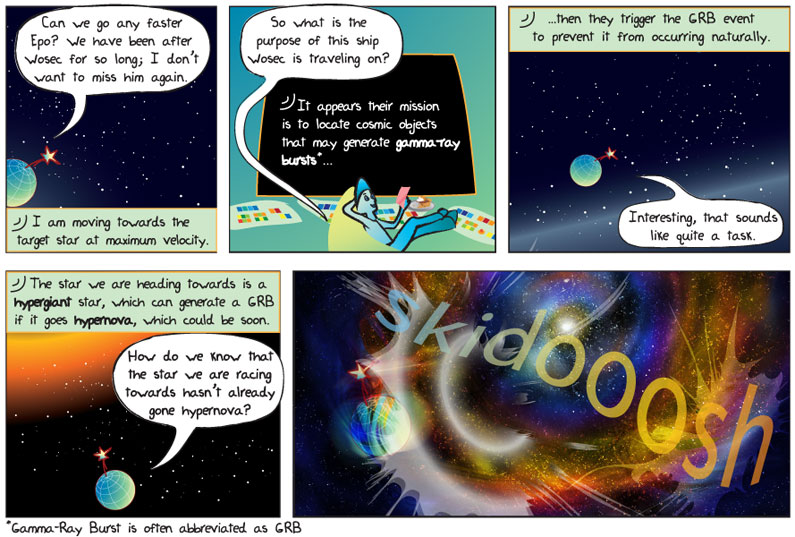
Comic Transcript
Panel 1.
Alkina: Can we go any faster Epo? We have been after Wosec for so long; I don’t want to miss him again.
Epo: I am moving towards the target star at maximum velocity.
Panel 2.
Alkina: So what is the purpose of this ship Wosec is traveling on?
Epo: It appears their mission is to locate cosmic objects that may generate gamma-ray bursts… (A gamma-ray burst is often abbreviated as GRB.)
Panel 3.
Epo: …then they trigger the GRB event to prevent it from occurring naturally.
Alkina: Interesting, that sounds like quite a task.
Panel 4.
Epo: The star we are heading towards is a hypergiant star, which can generate a GRB if it goes hypernova, which could be soon.
Alkina: How do we know that the star we are racing towards hasn’t already gone hypernova?
Panel 5.
[Epo is struck by a blast wave from the GRB]
What does it mean?
Gamma-ray burst – a brief, but very energetic burst of the most powerful form of electromagnetic radiation.
Hypergiant – These are the biggest stars in the Universe, more than 100 times the mass of our Sun and with up to millions of times its brightness. These stars are so bright that they burn through their fuel quickly, causing them to have short lifespans of only a million years or so. In comparison, our Sun’s lifespan is about 10 billion years.
Hypernova – The explosion of an extremely massive star at the end of its lifetime. The explosion is triggered when the star exhausts the nuclear fuel in its core and can no longer support itself against gravity. Hyperrnovae can liberate hundreds of times the energy of a supernova.
In human speak please!
Epo and Alkina are racing towards the last known location of Wosec Godilhase, who they hope can help them find their way back towards our solar system. Wosec travels on a ship which triggers gamma-ray bursts (GRBs). GRBs are the biggest bangs the cosmos has seen since the Big Bang itself. They represent violent events involving the most massive and energetic objects in the Universe. The energy released is more than our Sun will release over its entire 10 billion year lifespan, but in a hypernova the energy is released all at once. That’s equivalent to around 1032 nuclear bombs going off all at the same time. Scientists have never observed a GRB here in the Milky Way; they have only been seen in distant galaxies. For the brief time a burst exists, it outshines the combined output of all the other stars in its host galaxy.
There are several possible models for gamma-ray bursts, and they will be discussed in upcoming episodes. The model introduced in this episode is the collapse of a hypergiant star. When a star this massive reaches the end of its short life, the resulting explosion can be energetic enough to generate a gamma-ray burst. Smaller stars can still end their lives in violent explosions, called supernovae, but they are usually not energetic enough to produce large amount of gamma rays.
Detecting gamma-ray bursts is not easy. They are typically located at great distances, and they last for only a very brief time, sometimes much less than one second. What’s more, there is no warning about when and where a GRB is about to appear. In 2004, NASA launched the Swift satellite to tackle this problem. Swift contains three primary instruments: the Burst Alert Telescope (BAT), the X-ray Telescope (XRT) and the Ultraviolet/Optical telescope (UVOT). The BAT has a very wide field of view, and is constantly on the lookout for the high energy X-rays emitted during a gamma-ray burst. When it detects a burst; the satellite repositions itself to aim the XRT and UVOT, which have much narrower fields of view, to gather data from the GRB. This is all done quite rapidly, usually in just over a minute. Unlike many satellites, Swift’s name is not an acronym. Instead, it’s named for its unique capability to “swiftly” reposition itself to look towards a gamma-ray burst upon detection. Swift’s ability to quickly repoint its instruments has allowed it to observe many of the rapidly fading X-ray, optical, and ultraviolet traces of gamma-ray bursts.
Is that all?
Hypernova – The super-charged supernova and its link to gamma-ray bursts.NASA’s Swift Gamma Ray Burst Explorer, which orbits Earth 600 km (370 miles) up, explores the Universe in the optical, ultraviolet, X rays, and gamma rays. Swift has revolutionized astronomers’ understanding of gamma-ray bursts — the biggest explosions since the big bang.
